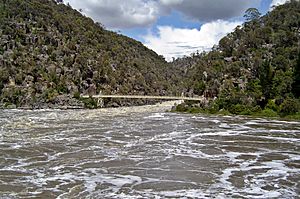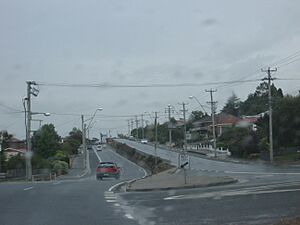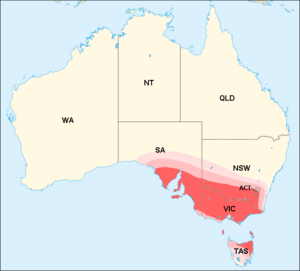Climate of Launceston, Tasmania facts for kids
Launceston, Tasmania, has a cool climate with four clear seasons. It's located in the Tamar Valley, surrounded by big hills and mountains. This means Launceston's weather can change quite quickly!
Contents
Launceston's Climate Basics
Launceston gets about 2,500 hours of sunshine each year. That's more sunshine than Melbourne, a city further north in mainland Australia!
The warmest months are January and February. The average temperature during these months ranges from 12.2°C (54°F) to 34.4°C (94°F). On average, there are about 4 days a year when the temperature goes above 30°C (86°F). The hottest temperature ever recorded in Launceston was 39°C (102°F) on January 30, 2009.
Winters are cool. The temperature often drops below 2°C (36°F) on about 61 days a year. July is the coldest month, with average temperatures from 2.2°C (36°F) to 12.5°C (54°F). The lowest temperature ever recorded was -5.2°C (23°F). Even though some cities at the same latitude (like Chicago) get lots of snow, Launceston rarely sees any.
Winter is also the calmest season with the least wind. Because of this and the valley shape, Launceston is famous for its foggy mornings in winter. In fact, Launceston Airport is the foggiest commercial airport in Australia!
The city gets about 665 mm (26 inches) of rain each year, spread over about 88 days. The wettest year on record was 1992, with 829.6 mm (32.7 inches) of rain. The driest year was 2006, with only 394.8 mm (15.5 inches) of rain.
Rainfall in Launceston

Launceston receives about 663.4 mm (26.1 inches) of rain each year. Most of this rain comes from cold weather fronts in winter. The mountains around Launceston often get snow in autumn, winter, and spring.
Launceston actually gets less rain than nearby areas, especially further north in the Tamar Valley. This happens because of something called a "rain shadow effect." The Western Tiers mountains, located west of the city, block some of the rain clouds, causing less rain to fall on Launceston.
| Jan | Feb | Mar | Apr | May | Jun | Jul | Aug | Sep | Oct | Nov | Dec | Yearly | ||
|---|---|---|---|---|---|---|---|---|---|---|---|---|---|---|
| Highest monthly rainfall | 139.4 | 107.4 | 106.2 | 124.6 | 152.9 | 183.0 | 157.7 | 183.6 | 115.8 | 121.4 | 85.2 | 145.1 | 829.6 | |
| Lowest monthly rainfall | 9.8 | 0.0 | 2.6 | 4.3 | 4.0 | 4.3 | 36.8 | 14.9 | 8.4 | 9.9 | 5.6 | 6.1 | 394.8 | |
| Source: Climate statistics for Launceston (Ti Tree Bend), Bureau of Meteorology | ||||||||||||||
| Climate data for Launceston | |||||||||||||
|---|---|---|---|---|---|---|---|---|---|---|---|---|---|
| Month | Jan | Feb | Mar | Apr | May | Jun | Jul | Aug | Sep | Oct | Nov | Dec | Year |
| Record high °C (°F) | 39.0 (102.2) |
34.4 (93.9) |
33.0 (91.4) |
27.7 (81.9) |
22.9 (73.2) |
18.4 (65.1) |
18.4 (65.1) |
20.3 (68.5) |
24.8 (76.6) |
28.7 (83.7) |
30.7 (87.3) |
33.8 (92.8) |
39.0 (102.2) |
| Mean daily maximum °C (°F) | 24.5 (76.1) |
24.6 (76.3) |
22.6 (72.7) |
19.0 (66.2) |
15.8 (60.4) |
13.2 (55.8) |
12.7 (54.9) |
13.8 (56.8) |
15.7 (60.3) |
18.2 (64.8) |
20.6 (69.1) |
22.6 (72.7) |
18.6 (65.5) |
| Mean daily minimum °C (°F) | 12.4 (54.3) |
12.3 (54.1) |
10.3 (50.5) |
7.5 (45.5) |
5.1 (41.2) |
2.9 (37.2) |
2.3 (36.1) |
3.6 (38.5) |
5.2 (41.4) |
7.0 (44.6) |
9.1 (48.4) |
10.8 (51.4) |
7.4 (45.3) |
| Record low °C (°F) | 2.5 (36.5) |
3.4 (38.1) |
0.5 (32.9) |
−1.5 (29.3) |
−3 (27) |
−4.9 (23.2) |
−5.2 (22.6) |
−3.5 (25.7) |
−2.4 (27.7) |
−1.4 (29.5) |
−2 (28) |
2.0 (35.6) |
−5.2 (22.6) |
| Average rainfall mm (inches) | 45.9 (1.81) |
31.2 (1.23) |
39.7 (1.56) |
49.7 (1.96) |
65.0 (2.56) |
67.4 (2.65) |
80.2 (3.16) |
84.8 (3.34) |
65.5 (2.58) |
49.6 (1.95) |
52.2 (2.06) |
48.7 (1.92) |
679.9 (26.78) |
| Average rainy days (≥ 0.2 mm) | 7.2 | 6.3 | 6.8 | 8.8 | 11.4 | 12.6 | 14.6 | 15.3 | 14.0 | 11.2 | 9.9 | 8.5 | 126.6 |
| Source: Bureau of Meteorology | |||||||||||||
Summer in Launceston
During summer, the lowest temperatures range from 9°C (48°F) in December to 10.3°C (50.5°F) in February. High temperatures go from 21.2°C (70°F) in December to 23.2°C (74°F) in February, which is the hottest month.
Temperatures above 30°C (86°F) are very rare in Launceston, happening on fewer than five days each year. In comparison, Melbourne might have thirty such days, and Adelaide over fifty!
Launceston doesn't get as many big thunderstorms as cities on mainland Australia. However, summer is when thunderstorms are most common. In 2001, a tornado even hit the Launceston suburb of Summerhill on Christmas Eve! It had winds estimated between 200 and 250 km/h (124-155 mph).
Rainfall is lowest during summer, with about 41.9 mm (1.6 inches) of rain over roughly 22 days during the three months.
| Record | Date | |||||||||||||
|---|---|---|---|---|---|---|---|---|---|---|---|---|---|---|
| Highest Summer Maximum Temperature | 39.9 °C (104 °F) | 30 January 2009 | ||||||||||||
| Lowest Summer Minimum Temperature | −1.0 °C (30 °F) | 20 December 1977 | ||||||||||||
| Highest Summer Monthly Rainfall | 164.1 millimetres (6.46 in) | February 1969 | ||||||||||||
| Lowest Summer Monthly Rainfall | 0.0 millimetres (0 in) | February 1983 | ||||||||||||
| Source: | ||||||||||||||
Autumn in Launceston
Autumn is a time of change, and usually has the most stable weather. However, Launceston's worst floods have both happened in autumn.
Lowest temperatures in autumn range from 5.1°C (41°F) in May to 10.0°C (50°F) in March. High temperatures go from 15.8°C (60°F) in May to 22.4°C (72°F) in March.
| Record | Date | |||||||||||||
|---|---|---|---|---|---|---|---|---|---|---|---|---|---|---|
| Highest Autumn Maximum Temperature | 34.9 °C (95 °F) | 4 March 1942 | ||||||||||||
| Lowest Autumn Minimum Temperature | −4.8 °C (23 °F) | 23 May 2001 | ||||||||||||
| Highest Autumn Monthly Rainfall | 183.6 millimetres (7.23 in) | May 1958 | ||||||||||||
| Lowest Autumn Monthly Rainfall | 2.1 millimetres (0.083 in) | March 1972 | ||||||||||||
| Source: | ||||||||||||||
Winter in Launceston
In winter, average low temperatures drop to 2.3°C (36°F) in July. Daytime highs range from 12.5°C (54°F) in July to 13.7°C (57°F) in August.
Winter is usually the season with the least wind. However, strong winds up to 113 km/h (70 mph) have been recorded during cold fronts in 1949 and 1984. These cold fronts make winter the wettest season for Launceston and northern Tasmania.
| Record | Date | |||||||||||||
|---|---|---|---|---|---|---|---|---|---|---|---|---|---|---|
| Highest Winter Maximum Temperature | 18.7 °C (66 °F) | 26 August 2004 | ||||||||||||
| Lowest Winter Minimum Temperature | −7.1 °C (19 °F) | 24 June 1972 | ||||||||||||
| Highest Winter Monthly Rainfall | 229.2 millimetres (9.02 in) | August 1936 | ||||||||||||
| Lowest Winter Monthly Rainfall | 8.2 millimetres (0.32 in) | June 2007 | ||||||||||||
| Source: | ||||||||||||||
Spring in Launceston
Spring is a time when the weather slowly changes from winter to summer. Cold weather visits Tasmania less often, and temperatures gradually start to rise.
Even though it's rare, snow has fallen in areas around Launceston as late as October in 1940, 1978, 2003, and 2020. October is the month when temperatures increase the most.
| Record | Date | |||||||||||||
|---|---|---|---|---|---|---|---|---|---|---|---|---|---|---|
| Highest Spring Maximum Temperature | 30.7 °C (87 °F) | 1 November 1987 | ||||||||||||
| Lowest Spring Minimum Temperature | −2.4 °C (28 °F) | 7 September 1994 | ||||||||||||
| Highest Spring Monthly Rainfall | 163.1 millimetres (6.42 in) | October 1947 | ||||||||||||
| Lowest Spring Monthly Rainfall | 8.0 millimetres (0.31 in) | September 1994 | ||||||||||||
| Source: | ||||||||||||||
The 2009 Heat Wave
In late January 2009, a major heat wave hit southeastern Australia. It caused record-breaking high temperatures that lasted for a long time. Over 50 places across Australia set new records for the hottest days and nights in a row.
This extreme heat wave happened because a slow-moving high-pressure system settled over the Tasman Sea. At the same time, a strong tropical low-pressure system and a monsoon trough (a low-pressure area) in northern Australia pulled hot tropical air down over southeastern Australia. The heat started in South Australia on January 25 and spread across the southeast by January 27.
A small cool change brought some relief to coastal areas on January 30. In Melbourne, the temperature dropped to an average of 30.8°C (87°F) that evening. However, even hotter temperatures returned the next weekend. Melbourne recorded its hottest day since records began in 1855: 46.4°C (115.5°F). This was also the hottest temperature ever recorded in an Australian capital city!
During this heat wave, many records were broken. Tasmania recorded its highest temperature ever: 42.2°C (108°F) in Scamander. The old Tasmanian record of 40.8°C (105.4°F) (from 1976) was broken five times in just two days! Launceston also recorded its highest temperature of 39.0°C (102.2°F) on January 30.
This heat wave also created very dangerous conditions for bushfires during the 2008–09 Australian bushfire season. It led to many fires in the affected areas, including the extreme bushfires on February 7, 2009, in Victoria, which tragically caused 173 deaths.
Launceston's Hottest Days in January 2009:
- 28th – 33.8°C (92.8°F)
- 29th – 36.9°C (98.4°F)
- 30th – 39.0°C (102.2°F) - This was the hottest day recorded in Launceston since records began in 1880.
- 31st – 38.2°C (100.8°F)



